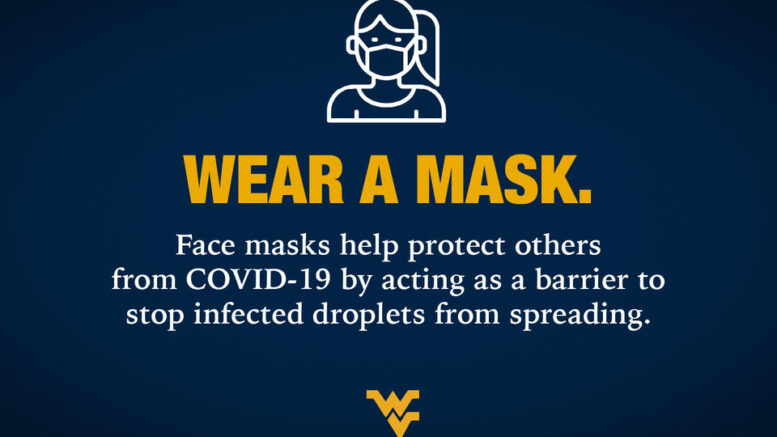The rate of COVID-19 positivity rates among young adults has been higher than other age groups during July and August. And, while the West Virginia University community is no stranger to doing its part to help suppress the positivity rate and keep others safe, there are significant factors that may result in WVU students letting down their guard when it comes to mitigation strategies – in particular, wearing a mask.
To combat this challenge, the WVU School of Public Health is partnering with the Centers for Disease Control and Prevention to conduct a seven-week mask observation study to estimate the percentage of people within the WVU community wearing masks correctly and, ultimately, increase the proportion of people who use masks correctly.
According to the CDC, one of the reasons for the increased positivity rates among the younger demographic may be that young adults have less concern about future health than older adults given that the disease severity tends to be lower at young ages. Use of face masks has been shown to reduce transmission of SARS-CoV-2, the virus that causes COVID-19.
“If students at WVU and other Institutes of Higher Learning do not follow recommended mitigation measures, such as wearing masks, the resulting spread of COVID-19 may adversely affect plans to continue in-person teaching,” said Keith Zullig, chair and professor in the Department of Social and Behavioral Sciences and principal investigator for the study. “More importantly, becoming infected with COVID-19 could lead to other significant health issues, regardless of age, so it’s important to do everything we can to prevent spread.”
Observing mask use can assist universities with determining the adherence among students, faculty and staff to inform public health decision-making.
For WVU’s study, eight students from the School of Public Health underwent observer training the week of Sept. 28 and began observing mask use at various locations throughout campus and the local community the week of Oct. 5. They will continue to conduct observation sessions through Nov. 22.
“Our observational methodology is designed to calculate an estimate of the percentage of people wearing masks correctly in public indoor settings within the larger population of WVU,” Zullig said. “A subtle data collection tool is being used to keep observations covert to avoid the Hawthorne effect – the alteration of behavior by study subjects due to their awareness of being observed.”
To that end, locations and the times of when the observations are taking place are not being disclosed.
Following are the results from the first round (Week 0) of observations, ending Oct.9, during which 389 people were observed. Of these observations:
- 331 (85.1%) wore masks
- 58 (14.9 %) did not wear masks
- 278 (84%) of those wearing masks wore them correctly.
- Additionally, observers noted the most common mask type was a cloth mask (N = 203 (61.3%).
“Although we’re encouraged by this positive, baseline data, these numbers still translate into about 1 in 4 people not wearing a mask correctly,” Zullig said. “We’ll continue to report our findings on a weekly basis between now and the week of Nov. 22, with the hope these numbers will improve. Our ultimate goal is to strengthen mitigation strategies and training while increasing the understanding of the importance of proper mask-wearing.”
Source: West Virginia University

Be the first to comment on "WVU Partners with the CDC to Conduct Mask Observation Study"